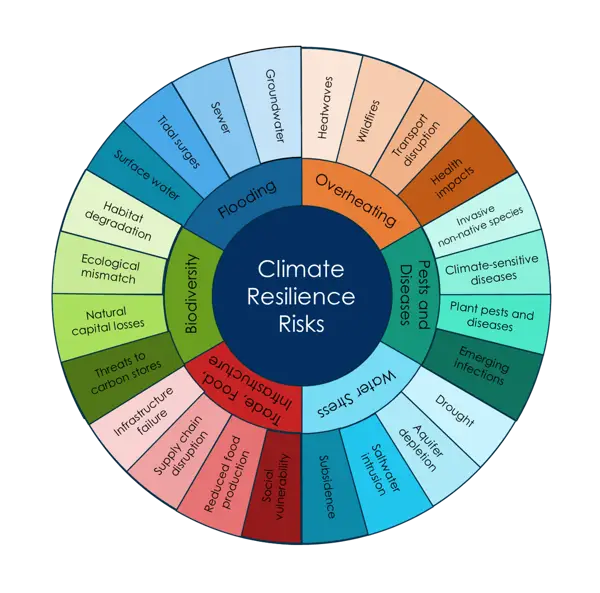Climate resilience
The City of London Corporation has committed to achieving climate resilience across our buildings, open spaces, public realm and infrastructure through the Climate Action Strategy.
The climate is changing and in the City of London, we can expect hotter, drier summers, warmer, wetter winters, more extreme weather events and sea level rise. Even with crucial efforts to reduce emissions and reach net zero within the Square Mile, we can still expect significant changes to our climate over the coming decades due to historic and global emissions.
In 2020, we commissioned Buro Happold to undertake an assessment of the climate-related risks that are likely to affect the City of London. The resulting Climate Resilience Adaptive Pathways Study established a series of actions that must be taken over time to ensure resilience to climate change, based on defined thresholds and trigger points in the future. The study identified six main risks from climate change to the City Corporation and Square Mile.
Six climate risks for the City Corporation and Square Mile
It is anticipated that the City will experience a change in both the frequency, intensity and season variability of rainfall in the future, which will put pressure on our drainage system. As the Lead Local Flood Authority for the Square Mile we're requiring new developments to include sustainable drainage system which will slow down the flow of water.
In addition, the City’s stretch of the Thames is tidal and will be affected by rising sea levels. The City is currently protected by river defences and the Thames Barrier downstream. In 2021, we adopted our Riverside Strategy in line with the Thames Estuary 2100 Plan to ensure these defences are resilient in the future.
You can find our more about flooding and the work of the Lead Local Flood Authority on our Flooding page.
Increasing temperatures and the frequency and length of heatwaves will be made worse in the City due to urban heat island effect. This is when dense urban areas remain significantly warmer than the surrounding countryside, due to roads and buildings absorbing and retaining heat in the day and re-emitting it at night.
We are increasing greening across the City to provide more shade and reduce the impact of the urban heat island effect. We require new developments to consider including green roofs, solar shading and planted areas, with the added benefit of reducing buildings’ energy consumption.
Changes in rainfall patterns will impact on London’s capacity to meet its water demand, which can lead to drought. Droughts are expected to get longer and occur more frequently, with double the number of days of drought predicted in 2050 compared to 2020.
We are trialling climate resilient planting in our gardens and open spaces to minimise water consumption, and are encouraging water efficiency measures in new developments through our planning policies.
Changes to the climate can fundamentally alter natural trends and cause decline and loss within ecosystems. This includes disruption to pollination systems, carbon storage capacity and our dependence on the natural environment for our wellbeing and resources.
While only a small proportion of the City is covered by gardens, parks and water, we are working to improve the connectivity of these natural spaces to combat losses to biodiversity. Our Biodiversity Action Plan focuses on managing our existing green spaces to benefit biodiversity, which is increasingly important as we look to natural solutions to mitigate flooding and improve air quality and shading.
Changing seasonal conditions and global patterns will influence the spread of new and emerging diseases, while pests and invasive non-native species may also increase in number and range in a warmer, wetter atmosphere. The City, with its high density of people and infrastructure, makes the likelihood and consequences of disease outbreaks particularly acute.
The urban heat island effect, complex international movements of people and trade and a variety of available habitats all make the introduction of non-native invasive species more likely. Some diseases show climate sensitivity with seasonal variation.
Weather-related impacts, geopolitical changes and altered climate conditions are likely to negatively impact upon major infrastructure, such as the power grid and transport network, as well as disrupting food production and trade on a domestic and international scale.
The City must ensure resilience to its critical infrastructure from a number of climate risks, such as flooding and overheating, as well as taking steps to secure its food supply.

As part of our Mainstreaming Climate Resilience programme, we are working across the City Corporation to develop Climate Adaptation Action Plans and upskill staff to build climate change considerations into decision making.
We are piloting a number of measures to tackle these climate risks in our public spaces and parks, such as tree planting and urban greening to reduce overheating, sustainable drainage systems (SuDS) to reduce flooding, and biodiversity enhancements as part of our Cool Streets and Greening programme.
We have also committed to improving resilience in our buildings through our Buildings Retrofit programme. Read more about our action to reduce emissions and our impact on the drivers of climate change on our Climate Action pages.
Climate catalogues and design notes
As part of our work to increase the climate resilience of the Square Mile we are developing resources and guidance. The first of which is a set of ‘Design Notes’.
This document is a starting point to evaluate how to shape the human experience in the public realm in a way that adds social value and enhances the resilience of the space. The guidance focuses on the use of materials. Please note this has to be read in conjunction with the ‘Scoring Matrix’.